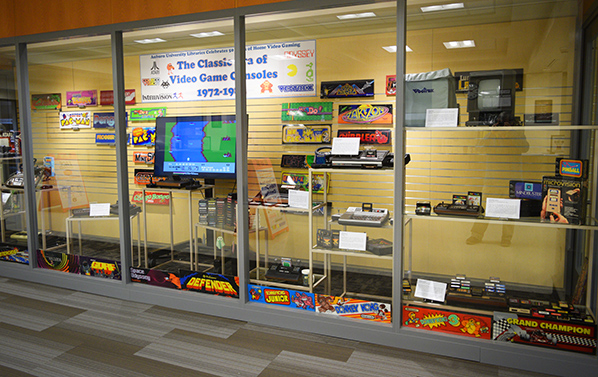The Classic Era of Video Game Consoles: 1972-1984 exhibit opens at RBD Library
Article body
Auburn University Libraries’ newest exhibit in Ralph Brown Draughon Library marks half a century of video game consoles with a selection of video game hardware and software from what is known as the “Classic Era” of video games: 1972-1984. This exhibit will be accessible during all regular library hours and is located in the first-floor exhibit space near the main circulation desk.
The Classic Era of video games was the period in which video games established themselves as mainstream entertainment both in the coin-operated arcades and on consoles at home. The birth of what would become the multi-billion dollar gaming industry of today was characterized by rapid innovation but ultimately this era ended with a crash in the video game industry in 1983-1984 due to overproduction and unlicensed, poor-quality games.
The exhibit was designed and executed by Auburn University Libraries’ Special Collections and Archives department head, Greg Schmidt, and history major student Tori Buchanan. It is made up of artifacts on loan from Auburn University alumni Jayson Hill, class of 1980. The artifacts represent the wide variety of technologies employed and the many companies that made hardware and software during this formative era.
“Auburn University Libraries and the Special Collections and Archives department try to craft exhibits that are engaging and informative,” said Schmidt. “Showcasing library, alumni, student and faculty collections is a great way to engage with the Auburn Family. The video gaming industry has become a major economic, technological, and creative force in our culture, and its history touches almost everyone. Creating this exhibit celebrating the 50th anniversary of home video gaming has been both fun and enlightening for us. I hope that visitors will enjoy this window into the birth of an industry.”
The Classic Era video game exhibit will be on display through spring semester 2022 and is open to the public.
A few of the more noteworthy exhibit artifacts include:
Magnavox Odyssey (1972) – the first home video game console. The exhibited example is autographed by the designer, Ralph Baer.
Atari Pong (1975) – the first of the dedicated Pong consoles from Atari. The exhibited example is autographed by Nolan Bushnell, the founder of Atari, and Bob Brown, one of the three engineers that put together the hardware.
Fairchild Channel F (1976) – the first Read Only Memory (ROM) cartridge programmable console and the first console to employ a microprocessor.
Atari Video Computer System (1977, a.k.a. Atari 2600) – the most popular of the Classic Era video game consoles, selling more consoles and games than all the other Classic Era programmable consoles combined.
Vectrex (1982) – a programmable standalone console that employed a vector graphics monitor rather than the raster scan TV monitors used by home consoles of the era. The exhibited example is autographed by the Smith Engineering design team.
Auburn University Libraries serves the more than 30,000 students and faculty of Auburn with a collection in excess of 7.5 million volumes. The Special Collections and Archives Department collects, preserves, and houses rare and unique items relating to the histories of Auburn University, the state of Alabama, the southeastern region, the Civil War, Native Americans and aviation. The Auburn University Digital Library develops accessible digital collections of materials that support the teaching and research of Auburn faculty and students, and that, in turn, further the mission of Auburn University. These collections are made available to researchers, educators and students in the state, nation and the world.
Submitted by: Jayson Hill





